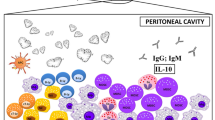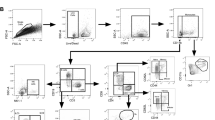Abstract
Susceptibility or resistance to infection with Cryptosporidium parvum correlates with the ability of mice to produce characteristic panels of cytokines in response to infection. Both adult healing and nonhealing mouse models of cryptosporidiosis were used to study the cell-mediated immune response during the course of C. parvum infection. Mesenteric lymph node (MLN) lymphocytes from both mouse models were proliferated after ex vivo re-stimulation with C. parvum sporozoite antigen. Study of the cytokine profile from the supernatant of proliferated MLN cells revealed that healing mice produced greater levels of Th1 (IFN-γ and IL-2) and moderate amounts of Th2 (IL-4, IL-5, IL-6, and IL-10) cytokines throughout the course of infection. Whereas, MLN cells from nonhealing mice produced no IFN-γ, low levels of IL-2 and IL-4, and higher levels of IL-5, IL-6, and IL-10 cytokines. These results suggest that the capacity to produce both Th1 and Th2 cytokines, rather than the presence of Th2 cytokines alone, determines the effective immune response against C. parvum infection.



Similar content being viewed by others
References
Abrahamsen MS, Templeton TJ, Enomoto S, Abrahante JE, Zhu G, Lancto CA, Deng M, Liu C, Widmer G, Tzipori S, Buck GA, Xu P, Bankier AT, Dear PH, Konfortov BA, Spriggs HF, Iyer L, Anantharaman V, Aravind L, Kapur V (2004) Complete genome sequence of the apicomplexan, Cryptosporidium parvum. Science 304:441–445
Aguirre SA, Mason PH, Perryman LE (1994) Susceptibility of major histocompatibility complex (MHC) class I- and MHC class II-deficient mice to Cryptosporidium parvum infection. Infect Immun 62:697–699
Aguirre SA, Perryman LE, Davis WC, McGuire TC (1998) IL-4 protects adult C57BL/6 mice from prolonged Cryptosporidium parvum infection: Analysis of CD4+alpha beta+IFN-gamma+ and CD4+alpha beta+IL-4+lymphocytes in gut-associated lymphoid tissue during resolution of infection. J Immunol 161:1891–1900
Chen W, Harp JA, Harmsen AG (1993a) Requirements for CD4+ cells and gamma interferon in resolution of established Cryptosporidium parvum infection in mice. Infect Immun 61:3928–3932
Chen W, Harp JA, Harmsen AG, Havell EA (1993b) Gamma interferon functions in resistance to Cryptosporidium parvum infection in severe combined immunodeficient mice. Infect Immun 61:3548–3551
Cosyns M, Tsirkin S, Jones M, Flavell R, Kikutani H, Hayward AR (1998) Requirement of CD40–CD40 ligand interaction for elimination of Cryptosporidium parvum from mice. Infect Immun 66:603–607
Current WL, Garcia LS (1991) Cryptosporidiosis. Clin Microbiol Rev 4:325–358
Enriquez FJ, Sterling CR (1991) Cryptosporidium infections in inbred strains of mice. J Protozool 38:100S–102S
Enriquez FJ, Sterling CR (1993) Role of CD4+ Th1-cell and Th2-cell-secreted cytokines in cryptosporidiosis. Folia Parasitol (Praha) 40:307–311
Fayer R, Ungar BL (1986) Cryptosporidium spp. and cryptosporidiosis. Microbiol Rev 50:458–483
Harp JA, Whitmire WM, Sacco R (1994) In vitro proliferation and production of gamma interferon by murine CD4+ cells in response to Cryptosporidium parvum antigen. J Parasitol 80:67–72
Hayward AR, Chmura K, Cosyns M (2000) Interferon-gamma is required for innate immunity to Cryptosporidium parvum in mice. J Infect Dis 182:1001–1004
Heine J, Moon HW, Woodmansee DB (1984) Persistent cryptosporidium infection in congenitally athymic (nude) mice. Infect Immun 43:856–859
Kuhls TL, Mosier DA, Abrams VL, Crawford DL, Greenfield RA (1994) Inability of interferon-gamma and aminoguanidine to alter Cryptosporidium parvum infection in mice with severe combined immunodeficiency. J Parasitol 80:480–485
Lacroix S, Mancassola R, Naciri M, Laurent F (2001) Cryptosporidium parvum-specific mucosal immune response in C57BL/6 neonatal and gamma interferon-deficient mice: Role of tumor necrosis factor alpha in protection. Infect Immun 69:1635–1642
Lean IS, McDonald SA, Bajaj-Elliott M, Pollok RC, Farthing MJ, McDonald V (2003) Interleukin-4 and transforming growth factor beta have opposing regulatory effects on gamma interferon-mediated inhibition of Cryptosporidium parvum reproduction. Infect Immun 71:4580–4585
McDonald V, Bancroft GJ (1994) Mechanisms of innate and acquired resistance to Cryptosporidium parvum infection in scid mice. Parasite Immunol 16:315–320
McDonald V, Deer R, Uni S, Iseki M, Bancroft GJ (1992) Immune responses to cryptosporidium muris and Cryptosporidium parvum in adult immunocompetent or immunocompromised (nude and scid) mice. Infect Immun 60:3325–3331
Mead JR, You X (1998) Susceptibility differences to Cryptosporidium parvum infection in two strains of gamma interferon knockout mice. J Parasitol 84:1045–1048
Perryman LE, Mason PH, Chrisp CE (1994) Effect of spleen cell populations on resolution of Cryptosporidium parvum infection in scid mice. Infect Immun 62:1474–1477
Sherwood D, Angus KW, Snodgrass DR, Tzipori S (1982) Experimental cryptosporidiosis in laboratory mice. Infect Immun 38:471–475
Smith LM, Bonafonte MT, Mead JR (2000) Cytokine expression and specific lymphocyte proliferation in two strains of Cryptosporidium parvum-infected gamma-interferon knockout mice. J Parasitol 86:300–307
Taghi-Kilani R, Sekla L, Hayglass KT (1990) The role of humoral immunity in cryptosporidium spp. Infection. Studies with B cell-depleted mice. J Immunol 145:1571–1576
Theodos CM (1998) Innate and cell-mediated immune responses to Cryptosporidium parvum. Adv Parasitol 40:87–119
Theodos CM, Sullivan KL, Griffiths JK, Tzipori S (1997) Profiles of healing and nonhealing Cryptosporidium parvum infection in C57BL/6 mice with functional B and T lymphocytes: the extent of gamma interferon modulation determines the outcome of infection. Infect Immun 65:4761–4769
Tzipori S (1988) Cryptosporidiosis in perspective. Adv Parasitol 27:63–129
Tzipori S, Rand W, Theodos C (1995) Evaluation of a two-phase SCID mouse model preconditioned with anti-interferon-gamma monoclonal antibody for drug testing against cryptosporidium parvum. J Infect Dis 172:1160–1164
Ungar BL, Burris JA, Quinn CA, Finkelman FD (1990) New mouse models for chronic cryptosporidium infection in immunodeficient hosts. Infect Immun 58:961–969
Ungar BL, Kao TC, Burris JA, Finkelman FD (1991) Cryptosporidium infection in an adult mouse model. Independent roles for IFN-gamma and CD4+ T lymphocytes in protective immunity. J Immunol 147:1014–1022
Urban JF Jr, Fayer R, Chen SJ, Gause WC, Gately MK, Finkelman FD (1996) IL-12 protects immunocompetent and immunodeficient neonatal mice against infection with Cryptosporidium parvum. J Immunol 156:263–268
Waters WR, Harp JA (1996) Cryptosporidium parvum infection in T-cell receptor (TCR)-alpha- and TCR-delta-deficient mice. Infect Immun 64:1854–1857
Waters WR, Harp JA, Nonnecke BJ (1996) In vitro blastogenic responses and interferon-gamma production by intestinal intraepithelial lymphocytes of calves. Res Vet Sci 61:45–48
Whitmire WM., Harp JA (1990) In vitro murine lymphocyte blastogenic responses to Cryptosporidium parvum. J Parasitol 76:450–452
Widmer G, Tzipori S, Fichtenbaum CJ, Griffiths JK (1998) Genotypic and phenotypic characterization of Cryptosporidium parvum isolates from people with aids. J Infect Dis 178:834–840
You X, Mead JR (1998) Characterization of experimental Cryptosporidium parvum infection in IFN-gamma knockout mice. Parasitology 117(6):525–531
Acknowledgements
We gratefully acknowledge Dr. Jean Mukerjee for the critical review of the manuscript. This work was supported by National Institute of Health Grants R29-AI39967, R01-RR13537, and P01-DK55510.
Author information
Authors and Affiliations
Corresponding author
Rights and permissions
About this article
Cite this article
Singh, I., Theodos, C., Li, W. et al. Kinetics of Cryptosporidium parvum-specific cytokine responses in healing and nonhealing murine models of C. parvum infection. Parasitol Res 97, 309–317 (2005). https://doi.org/10.1007/s00436-005-1436-1
Received:
Accepted:
Published:
Issue Date:
DOI: https://doi.org/10.1007/s00436-005-1436-1




